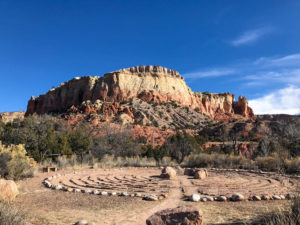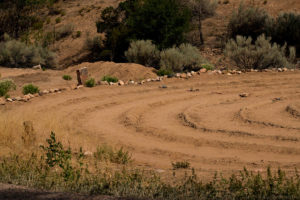“Labyrinth” according to Merriam-Webster, is defined as a complicated irregular network of passages or paths in which it is difficult to find one’s way; a maze.
But the labyrinths in my travels are not mazes, but uni-directional paths that offer a very soulful, and some would say spiritual, experience.
Labyrinths are said to date back to the Greeks in Knossos where designs started to appear in the 5th to third century B.C. Later, in the 12th century they would start to appear in Europe and elsewhere. From Egypt to India, to the Hopi Mesas, to English village greens, the labyrinth became a world wide architectural and artistic phenomena. Perhaps one of the most famous is at Chartres which measures 42 feet in diameter and whose construction dates to 1201.
Labyrinths, often constructed of simple stones, create a path that twists and turns, seemingly doubling back on itself, while always moving forward. The meandering walkway follows a precise path, offering an opportunity to take a journey within and reflect upon whatever arises.
The experience of walking a labyrinth is simultaneously thoughtful and mindless. It is mindless in that you are not required to think, but just to be in the moment and follow the carefully laid out path before you.
It is thoughtful in that it is essentially a silent meditation.
Walking is a chance to pause, to reflect, to not think if you choose.
And in entering this space, time disappears. Here, now, one’s focus is simply on the present.
***
There are many theories about these curious structures. They appear in drawings, mosaics, as imprints in coins and art, in gardens and on land. The Greeks used a labyrinth symbol in their coins on Knossos:

The famous labyrinth in the Chartres Cathedral, 1750
This coin is an example of the seven circuit style, aka the classic labyrinth (versus the Medieval labyrinth). The Medieval pattern was often embedded in church floors such as at the Cathedral at Chartres, and was said to represent the intersection of faith, life and philosophy.
As colonial influences spread, so did the labyrinth. But many labyrinths seem to predate these migration patterns. From Wikipedia:
Equally puzzling are the labyrinths found carved and painted on cave and temple walls in India and on tribal objects from Sumatra and Java – how and when the labyrinth reached these remote areas remains difficult to fully explain. Likewise the occurrence of the symbol amongst rock art in the American Southwest – was this an independent discovery of the design, or a European introduction?
A Trail of Travel Serendipity

Labyrinth at Ghost Ranch, NM
On a recent trip to Ghost Ranch I came upon a labyrinth; and then I met a woman in Santa Fe who was part of the Labyrinth Society. And on this summer day, the Labyrinth Society has a walk at Museum Hill. So I thought I’d attend.

Music accompanies the labyrinth walk outside the Folk Art Museum on Museum Hill
Serendipity seems to unfold before me. I walked up to the table where I was greeted. And I got talking to one of the women at the welcoming desk.
The woman, it turns out, also had cancer some years ago. “It changed my life for the better,” she confided. I knew what she meant. Knowing that one’s time is limited, makes us appreciate the great gift of life.
And labyrinths are part of that gift. They are an opportunity to stop, to reflect and to simply be. It’s a time out in a busy day. This day at Museum Hill, at mid-day, the leaves tussle in the afternoon breeze carrying the soft melody of the guitar, and twenty people or so slowly weave their way through the green and red pavers of the labyrinth in front of the Folk Art Museum.
The Labyrinth Society has an online labyrinth you can “walk” with your mouse. But if at all possible, I suggest you go exploring for a real labyrinth experience. As I got to. My chance conversation led to a morning with Santa Fe Labyrinth Resource Group founder, Marge McCarthy.
Exploring the Labyrinths of Santa Fe
The official list of labyrinths in Santa Fe includes about a dozen different sites. In addition to the public sites, labyrinths can also be found in communities and private yards.
Perhaps the most prominent labyrinth is the one at the Cathedral Basilica of St. Francis of Assisi, downtown.

The labyrinth at the Cathedral Basilica of St. Francis of Assisi lies under the left(eastern) bell tower.

Evening light spreads across the stone labyrinth at the Cathedral Basilica of St. Francis of Assisi

A bench offers a place to pause at the church’s labyrinth.
This particular labyrinth is set off to the side so the casual visitor might overlook it. It’s a classic Chartres style labyrinth, that is found throughout Europe, Scandinavia, India and North Africa.
Labyrinth historians categorize these circuitous paths based on their shape, the number of circuits and the time period. They can be left handed or right handed; have 7, 9, 11 or more (or fewer) circuits. But all labyrinths have one thing common: the are unicursal, ie. a single path that takes an pre-planned and intricate path into the center and back again.
Labyrinth Construction
Labyrinth construction varies widely. Some labyrinths are more formal, made of carefully laid stone as part of a plaza. Some are casual, rocks in concentric circles in a field or even ridges of earth. Some are cut into turf. They can be permanent or temporary, as in the case of a labyrinth on canvas.
All labyrinths follow basic rules of construction, where the labyrinth is carefully measured and laid out, prior to building.
And, according to Marge McCarthy, a dowser should be employed to determine the location and entrance of the labyrinth.
Dowsing involves not water, but energy. The person or shaman doing the dousing is seeking to align the energetic center of the labyrinth with the energy of the earth. Marge tells an interesting story of having several dowsers out to a particular labyrinth. And each found the exact same location.
Once the center is established, the lines are carefully measured and laid out. Depending on the size of the construction team and location, hours (or even days!) are then spent bringing the labyrinth to life, as the concentric rings are carefully constructed. Exacting measurements at the beginning of the process insure a properly aligned end product.
If you’ve never walked a labyrinth, it’s something to put on your list of things to try. It’s experiential. The emotion of finding oneself “lost” while on the path; the turning points; the arrival at the center and the act of departing can have deep impact. I know that these curious pathways are now on my travel list. Here are a a few of my favorites from the Santa Fe area to date:
Aldea Labyrinth
Aldea is a residential community north of Santa Fe, and the labyrinth here was spearheaded as a community effort some years ago. Marge hadn’t been out recently, so we weren’t sure what we would find. But we found a well cared for labyrinth in a field with views of the distant mountains:

Aldea labyrinth was a community effort.

Aldea Labyrinth
There is something a bit magical about finding a labyrinth where one might not expect it. Who built it? Why here? Every labyrinth has a story.
Frenchy’s Field

The Frenchy’s Field Labyrinth is made of clay and straw. It requires frequent maintenance.
The Santa Fe Interfaith Council sponsored this labyrinth in 1998. This seven circuit labyrinth (there are seven concentric circles, thus a seven circuit labyrinth) is high maintenance. The combination of adobe type materials, hot sun and torrential downpours weathers the ridges that make up the pathways.
It’s located in Frenchy’s Field, on Agua Fria which runs along the river. The park has been owned by a host of owners, starting with the Pueblo people and more recently, many recall Frenchy’s Sunshine Dairy, which lent their name to the park. It’s a gathering place for everything from walks along the river, to laughter yoga, to Tai Chi.

Prayer flags wave from a primitive shelter at the start of the labyrinth.
Public and Hidden Labyrinths
Some of the better know labyrinths around town include the Christ Lutheran Church at 1701 Arroyo Chamiso Road, a modified seven circuit Chartres style; the labyrinth at the Museum of International Folk Art; the Railyard; the Santa Fe Community Yoga Center; Southwestern College and Community Church.

At a busy intersection, surrounded by trees is the labyrinth at Christ Lutheran Church, Santa Fe, NM
But tucked away, just to the north of Santa Fe is my favorite labyrinth. It’s small and nestles near an arroyo. The location I cannot disclose. But the pictures I can share:

The path to the hidden labyrinth
“Those that don’t believe in magic will never find it.”
–Roald Dahl

A small 5 circuit Labyrinth tucked away near Santa Fe
There is something magical about coming across a labyrinth in the middle of nowhere. Mind, body and spirit join the earth in a walk as old as the ages.
May you discover the wonder of labyrinth walking in your travels.
Labyrinth Walks in Santa Fe
Upcoming Labyrinth Walk in Santa Fe
Path of Forgiveness
Sunday, August 26, 5:00pm
Harp music by Kathleen Cosgrove
The Cathedral Basilica of St. Francis of Assisi, 131 Cathedral Place
A short Ted talk on the impact of labyrinths on one young woman:
More Reading on Labyrinths
Lauren Artress reintroduces the ancient labyrinth, a walking meditation that trancends the limits of still meditation, and shows us the possibilities it brings for renewal and change.
‘Walking the Labyrinth’ has reemerged today as a metaphor for the spiritual journey and a powerful tool for transformation. This walking meditation is an archetype, a mystical ritual found in all religious traditions. It quiets the mind and opens the soul. Walking a Sacred Path explores the historical origins of this divine imprint and shares the discoveries of modern day seekers. It shows us the potential of the Labyrinth to inspire change and renewal, and serves as a guide to help us develop the higher level of human awareness we need to survive in the twenty-first century.
The first time Helen Curry walked a labyrinth she was moved to tears and then “was filled with peace and possibilities.” Here, she shares her years of experience with labyrinth meditation and shows how others can find serenity and guidance by adopting this increasingly popular practice. Unlike mazes, which force choices and can create fear and confusion, labyrinths are designed to “embrace” and guide individuals through a calming, meditative walk on a single circular path. The Way of the Labyrinth includes meditations, prayers, questions for enhancing labyrinth walks, guidelines for ceremonies, instructions for finger meditations, and extensive resources. This enchanting, practical, and exquisitely packaged guide helps both novice and experienced readers enjoy the benefits of labyrinth meditation, from problem-solving to stress reduction to personal transformation. Includes a foreword by Jean Houston, the renowned author and leader in the field of humanistic psychology, who is considered the grandmother of the current labyrinth revival.
Laybrinths and mazes are found all over the world and have been a source of wonder throughout history. This work explores the many aspects of labyrinths from their architectural, astrological and mythological significance to their iconographical , mathematical and artistic fascination. It is an introduction to such different labyrinth forms as rock engravings on Trojan castles, medieval manuscripts, church labyrinths and Baroque garden mazes. He traces the origins, developments and changing meanings of this mystic form from the Bronze Age to the present day. The labyrinth’s dominant position in Western civilization is supplemented by explorations in other cultures around the globe, including those of Egypt, India and North America. By taking a close look through the centuries at different cultures and across the continents, the cultural and historical significance of the maze takes on a new light.
More About Visiting Santa Fe
Four Museums and a Garden: Visiting Museum Hill In Santa Fe
The Zen of Upaya
The Art, Culture and Beauty of Santa Fe
Like This Post? Pin It!

If you’re interested in learning more about photography (or cooking or film or any number of topics) check out MasterClass All-Access Pass for on-line excellence.
[et_bloom_inline optin_id=”optin_10″]
What is #CancerRoadTrip and how did it come to be? Read this post to get the backstory!
Follow me on Twitter, Pinterest, Instagram, and at Anti-Cancer Club. Connect with me! I may need a place or two to stay along the way!














Great article! I think that walking the Labyrinth has been really helpful for me when I am in need of time to sort through a dilemma. I am much better at moving than sitting still and meditating and the labyrinth offers me a way to do both.
Update from 1/13/2019:
A new labyrinth was constructed yesterday in front of St Bedes’ Church. A few final tweaks and it’s ready to receive walkers from the community. It’s located on San Mateo, at the intersection with St Francis Drive. Peace
Thank you for the heads up! I’ll have to check it out.
Great article! I think that walking the Labyrinth has been really helpful for me when I am in need of time to sort through a dilemma. I am much better at moving than sitting still and meditating and the labyrinth offers me a way to do both.